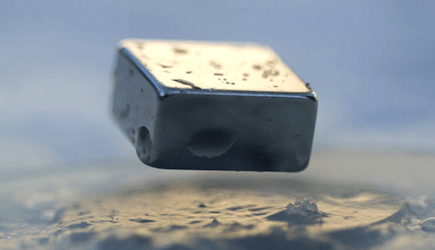Scientists Control Superconductors With Rays Of Light

A century after the discovery of superconductivity mankind is still struggling to harness its tantalizing possibilities. Superconductors allow an electric current to flow with zero resistance giving us lossless energy transfer. A looped superconductive wire can carry a charge forever with no power source.
Superconductors also have extraordinary magnetic properties. Because they exclude magnetic fields from their interior, they cause magnets to levitate -again forever. A property that can be use...
A century after the discovery of superconductivity mankind is still struggling to harness its tantalizing possibilities. Superconductors allow an electric current to flow with zero resistance giving us lossless energy transfer. A looped superconductive wire can carry a charge forever with no power source.
Superconductors also have extraordinary magnetic properties. Because they exclude magnetic fields from their interior, they cause magnets to levitate -again forever. A property that can be used for superfast low-energy transportation like levitated, frictionless trains.
And than there are the medical diagnostic applications, the promise of superfast low-energy computers, wireless signal boosting and more [PDF]. Superconductivity can radically change the world we live in.
But there’s a snag. Every superconductive material has a critical temperature at which resistance suddenly drops to zero but these are extremely low. Even most High Temperature Superconductors operate in the temperature range of liquid nitrogen (77 K, -196 C, -321 F).
Obviously, the cryogenic operating environment somewhat hampers the usability of the quantum mechanical phenomenon.
So scientists across the planet are looking for ways to bend the elusive materials to their will. One much tried process is chemical doping, adding or removing ions to alter the critical temperature (Tc).
In search for a simpler method to manipulate superconductive materials a team of Israeli researchers has discovered they can control superconductors by exposing them to light.
Prof. Yoram Dagan and his team of the Department of Physics and Center for Nanoscience and Nanotechnology of Tel Aviv University wrapped a 50 nanometer thick conductive material in a one-molecule thick layer of organic material. When the molecules were exposed to light they changed shape. In reaction the properties of the conductive material changed -including the critical temperature.
They tested this process with layers of three different kinds of molecules to different effects. The first molecule layer increased the Tc. Under the influence of the second molecule Tc increased when exposed to UV light but lowered when exposed to visible light. The third molecule layer raised the Tc when exposed to light but dropped again to its normal state when the light was turned off.
With that third layer Dagan and his team have effectively created an on/off switch for superconductors. Instead of having to change the temperature of the material itself –a complex process- they can ontrol it with a ray of light.
Image: supraconductivite.fr
Superconductors also have extraordinary magnetic properties. Because they exclude magnetic fields from their interior, they cause magnets to levitate -again forever. A property that can be used for superfast low-energy transportation like levitated, frictionless trains.
And than there are the medical diagnostic applications, the promise of superfast low-energy computers, wireless signal boosting and more [PDF]. Superconductivity can radically change the world we live in.
But there’s a snag. Every superconductive material has a critical temperature at which resistance suddenly drops to zero but these are extremely low. Even most High Temperature Superconductors operate in the temperature range of liquid nitrogen (77 K, -196 C, -321 F).
Obviously, the cryogenic operating environment somewhat hampers the usability of the quantum mechanical phenomenon.
So scientists across the planet are looking for ways to bend the elusive materials to their will. One much tried process is chemical doping, adding or removing ions to alter the critical temperature (Tc).
In search for a simpler method to manipulate superconductive materials a team of Israeli researchers has discovered they can control superconductors by exposing them to light.
Prof. Yoram Dagan and his team of the Department of Physics and Center for Nanoscience and Nanotechnology of Tel Aviv University wrapped a 50 nanometer thick conductive material in a one-molecule thick layer of organic material. When the molecules were exposed to light they changed shape. In reaction the properties of the conductive material changed -including the critical temperature.
They tested this process with layers of three different kinds of molecules to different effects. The first molecule layer increased the Tc. Under the influence of the second molecule Tc increased when exposed to UV light but lowered when exposed to visible light. The third molecule layer raised the Tc when exposed to light but dropped again to its normal state when the light was turned off.
With that third layer Dagan and his team have effectively created an on/off switch for superconductors. Instead of having to change the temperature of the material itself –a complex process- they can ontrol it with a ray of light.
Image: supraconductivite.fr
